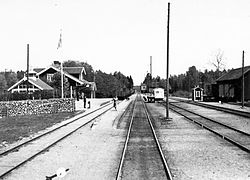Sala – Gävle railway line
| Sala-Gävle | |||||||||||||||||||||||||||||||||||||||||||||||||||||||||||||||||||||||||||||||||||||||||||||||||||||||||||||||||||||||||||||||||||||||||||||||||||||||||||||||||||||||||||||||||||||||||
|---|---|---|---|---|---|---|---|---|---|---|---|---|---|---|---|---|---|---|---|---|---|---|---|---|---|---|---|---|---|---|---|---|---|---|---|---|---|---|---|---|---|---|---|---|---|---|---|---|---|---|---|---|---|---|---|---|---|---|---|---|---|---|---|---|---|---|---|---|---|---|---|---|---|---|---|---|---|---|---|---|---|---|---|---|---|---|---|---|---|---|---|---|---|---|---|---|---|---|---|---|---|---|---|---|---|---|---|---|---|---|---|---|---|---|---|---|---|---|---|---|---|---|---|---|---|---|---|---|---|---|---|---|---|---|---|---|---|---|---|---|---|---|---|---|---|---|---|---|---|---|---|---|---|---|---|---|---|---|---|---|---|---|---|---|---|---|---|---|---|---|---|---|---|---|---|---|---|---|---|---|---|---|---|---|---|
|
Runhallen station in 1937
| |||||||||||||||||||||||||||||||||||||||||||||||||||||||||||||||||||||||||||||||||||||||||||||||||||||||||||||||||||||||||||||||||||||||||||||||||||||||||||||||||||||||||||||||||||||||||
| Route length: | 99.15 km | ||||||||||||||||||||||||||||||||||||||||||||||||||||||||||||||||||||||||||||||||||||||||||||||||||||||||||||||||||||||||||||||||||||||||||||||||||||||||||||||||||||||||||||||||||||||||
| Gauge : | 1435 mm ( standard gauge ) | ||||||||||||||||||||||||||||||||||||||||||||||||||||||||||||||||||||||||||||||||||||||||||||||||||||||||||||||||||||||||||||||||||||||||||||||||||||||||||||||||||||||||||||||||||||||||
| Maximum slope : | 11 ‰ | ||||||||||||||||||||||||||||||||||||||||||||||||||||||||||||||||||||||||||||||||||||||||||||||||||||||||||||||||||||||||||||||||||||||||||||||||||||||||||||||||||||||||||||||||||||||||
| Minimum radius : | 400 m | ||||||||||||||||||||||||||||||||||||||||||||||||||||||||||||||||||||||||||||||||||||||||||||||||||||||||||||||||||||||||||||||||||||||||||||||||||||||||||||||||||||||||||||||||||||||||
| Top speed: | 60 km / h | ||||||||||||||||||||||||||||||||||||||||||||||||||||||||||||||||||||||||||||||||||||||||||||||||||||||||||||||||||||||||||||||||||||||||||||||||||||||||||||||||||||||||||||||||||||||||
Sources: |
|||||||||||||||||||||||||||||||||||||||||||||||||||||||||||||||||||||||||||||||||||||||||||||||||||||||||||||||||||||||||||||||||||||||||||||||||||||||||||||||||||||||||||||||||||||||||
The Sala – Gävle railway , also known colloquially as Salabanan , was a standard gauge railway in Sweden . The line was built by the company Sala-Gysinge-Gävle-Järnväg (SGGJ) between 1898 and 1901 and connected the Mora – Uppsala line near Sala with the Falun – Gävle line near Hagaström. The main purpose of the line was to connect the Gysinge bruk ironworks, which was important at the time, and other industrial companies in the area to the rail network.
history
prehistory
By the end of the 19th century, the Gysinge Bruk ironworks had developed into one of the largest ironworks in Sweden and more industry had settled in the area. In the early 1890s, several proposals were made to connect Gysinge to the growing Swedish rail network. Agreement was quickly reached on the route from Sala to Gysinge, but not on the further route north of Gysinge. Two alternatives were proposed here, a western route via Årsunda and an eastern route via Hedesunda, which was to connect to the then still private route Gävle-Dala-Järnväg at Hagaström . Even after numerous discussions between representatives of the affected communities and industrial companies as well as the neighboring railway companies, no agreement could be reached. In the end, two different license applications were submitted to the King of Sweden. The king asked various institutions, including the railway authority and the chief of staff, for comments. These advocated the eastern route without exception, which is why a license was granted on December 22, 1897.
Sala-Gysinge-Gävle-Järnväg
Construction of the line began in May 1898 from both ends. One construction team worked its way from Sala towards Gysinge, the other from Hagaström. The Hagaström – Gysinge section was completed on December 22, 1900. The route starting from Sala reached Kerstinbo on December 28, 1900. The Kerstinbo – Gysinge section was delayed until May 15, 1901, as a 350 meter long bridge had to be built over the Dalälven river. On June 29, 1901, the entire line was officially inaugurated.
Economic situation
In the opening year of the line in 1901, the sulphite works in Gysinge, which should have become an important freight traffic customer, burned down. The plant was not rebuilt. Only a few years later a steelworks was built in its place, but this did not require as much freight traffic by a long way. The connection to the Gävle – Dala-Järnväg route outside the city area, which was made necessary by the city of Gävle's refusal to approve another railway line on its territory, also led to economic problems, as Gävle – Dala-Järnväg insisted on it being between Hagaström and Gävle to drive all trains with their own locomotives and staff.
business
In the first few years after commissioning, the route was only used by two pairs of trains as planned. Both were freight trains with passenger transport . In addition, other freight trains ran as required. From the timetable change in May 1903, a pure passenger train pair was added, which ran beyond Sala to Tillberga.
In order to satisfy the increasing demand for fast passenger transport connections in the second half of the 1920s, three bogie passenger cars were converted into railcars between 1926 and 1927. A gas engine was used as the drive , the gas came from a coal gas generator, which could be operated either with charcoal, hard coal or coke. However, the railcars did not prove themselves, the engines were too weak. As a result, they were dismantled back into passenger cars as early as 1928, and their routes were driven by locomotive-hauled trains.
nationalization
Due to the permanent economic difficulties, the line was nationalized a few years before the general Swedish nationalization of the railway on October 1, 1937.
After the nationalization, the time-consuming and costly personnel and locomotive changes in Hagaström could be dispensed with. The passenger trains continued to run as locomotive-hauled trains. It was not until the early 1950s that passenger transport was switched to rail buses.
Shutdown
On January 1, 1964, passenger traffic on the entire route and freight traffic on the Skärsjö – Mackmyra section were shut down. In the 1970s, further, partial shutdowns and the first dismantling work took place. The last train ran on June 12, 1995 between the Råsboda gravel pit and Sala. Disused sections were dismantled immediately.
Individual evidence
-
↑ Sala-Runhallen-Gysinge. Bandel 213, SJ district 35. In: banvakt.se. Retrieved November 6, 2019 (Swedish). Gysinge-Hagaström. Bandel 214, SJ district 35. In: banvakt.se. Retrieved November 6, 2019 (Swedish). SGGJ, Sala - Gysinge - Gävle Järnväg. In: historiskt.nu. Retrieved November 6, 2019 (Swedish).
- ↑ Rolf Sten: SGGJ, Sala - Gysinge - Gävle Järnväg. Järnvägens förhistoria och tillkomst. In: historiskt.nu. October 25, 2005, Retrieved November 7, 2019 (Swedish).
- ↑ Gysinge Bridge. In: Järnriket. Länsmuseet Gävleborg, accessed on November 7, 2019 (Swedish).
- ↑ a b c Rolf Sten: SGGJ, Sala - Gysinge - Gävle Järnväg. Tobacco Shops. In: historiskt.nu. October 25, 2005, Retrieved November 7, 2019 (Swedish).
- ↑ Rolf Sten: SGGJ, Sala - Gysinge - Gävle Järnväg. Motorvagnsepoken. In: historiskt.nu. October 25, 2005, Retrieved November 8, 2019 (Swedish).
- ↑ Rolf Sten: SGGJ, Sala - Gysinge - Gävle Järnväg. Förstatligandet. In: historiskt.nu. October 25, 2005, Retrieved November 8, 2019 (Swedish).
